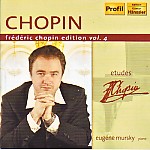Chopin’s Etudes pose no technical difficulties at all for Eugene Mursky, although some interpretations succeed more than others. In Op. 10, No. 1’s long-limbed right-hand arpeggios flow like oil, even when Mursky abandons the sustain pedal when the opening bars recapitulate. Similar variety of articulation infuses the Revolutionary Etude (No. 12) with point and drama, yet the pianist’s accelerations in No. 4 seem more fidgety than inherently exciting. Nos. 5, 7, and 8 are proficiently dispatched but lack requisite suppleness and lilt. Op. 25’s 12 pieces also hit and miss. Mursky overpedals No. 2 to the point where the two-part texture often blurs. The double-note studies (Nos. 6 and 8) come nowhere near the poise and aplomb our reference competitors possess (to say nothing of Pollini and Ashkenazy). However, the last three etudes soar with no apparent effort.
In the Nouvelle Etudes, the F minor’s three-against-four patterns register clearly, while Mursky’s superbly differentiated legato and detached articulation in the D-flat more than compensates for a fanciful phrase or two (or three!). By contrast, Mursky’s facile, uninvolved treatment of the inspired A-flat piece disappoints, as does his lack of simplicity in the lyrical Op. 10 No. 3 and Op. 25 No. 7 selections. Profil’s sonics are bright, top heavy, and a bit overresonant.
































